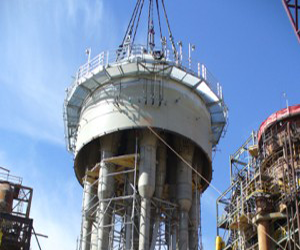With some refiners planning to shift the gasoline-to-propylene ratio towards higher propylene yields after Tier 3 regulations come into effect January 1, 2017, this will affect fractionation configurations for the FCC main fractionator and other linked fractionation systems (e.g., primary absorber). About 67 of the 108 U.S. refineries affected by Tier 3 regs still need to make the investments to achieve less than 10 ppm sulfur in fuels. The EPA will give some of them six years to meet the specs. How much of that process investment revolves around reducing sulfur from FCC gasoline will affect the reactor, distillation and fractionation systems, and other linked process systems, as discussed by Ginger Keady from Technip’s FCC group:

FCC cyclones with diplegs
The shift from gasoline-to-propylene ratio with higher propylene yields in a FCC can significantly impact the main fractionator (MF) and the unsaturated gas plant (UGP). Adjusting the FCC feed rate to meet the MF/UGP operational upper limits has not been a preferred option. Most refineries choose to make small incremental increases in propylene yields to avoid a major MF/UGP revamp with parallel/new compressors and towers.
The availability of light tight oil (LTO) crude feedstocks to refineries can result in a decrease of heavy cuts from the crude tower. A lower feed rate to the FCC could be a viable option for higher propylene yields with lower investment. FCC licensors such as Technip can recommend the feed rate sweet spot for both the reactor/regenerator (RR) and MF/UGP operation.
A careful analysis of the MF/UGP based on operating data and equipment mechanical performance for a range of yields can reveal the most effective and economic FCC feed rate. Since the MF/UGP, with compression and fractionation, is more constrained than the FCC RR by the feed rate changes coupled with high propylene yields, a systematic approach is required. First, the wet gas compressor (WGC) operational limit with reasonable modifications determines the optimal FCC feed rate. Second, the MF vapor/liquid traffic and required heat removal in the UGP points to another feed rate pinch point. Third, depending on the increase in propylene production along with the accompanying C4’s, the depropanizer performance is maximized by replacement of internals but the tower is not replaced or paralleled.
Other consideration include setting the expected propylene recovery in the primary absorber by dictating the appropriate lean oil from the debutanizer and possible refrigerated absorber intercooling. Gasoline product specification such as summer/winter RVP determines the revamp requirements of the debutanizer. A stripper study will check for light ends stripping of the propylene/propane product. Fuel gas specifications impact the operation of the secondary absorber and the need for lean oil from the MF.
If a propylene recovery unit (PRU) is part of the FCC complex, the C3 splitter plus contaminant removal must be evaluated. The C3 splitter and associated equipment can be revamped for increased capacity.
If a PRU is not part of the FCC complex, then other alternatives are available. Exporting C3/C4’s to a petrochemical complex is one and another is producing cumene, a gasoline blending component, from the C3 stream in a BENZOut process. Also, more propylene/butylene is available for alkylation requiring an evaluation of the alkylation unit.
When running the FCC in higher propylene mode, the FCC naphtha becomes lighter with more C5/C6 naphtha produced. The gasoline hydrotreater SHU and splitter work harder to separate the light, olefinic naphtha that contributes octane to the gasoline pool. The removed light naphtha fraction then by-passes the hydrotreater, obtaining a slight hydrotreater debottleneck.
2 responses to “FCC Gasoline Sulfur & the Tier 3 Deadline: Finding the Sweet Spot”
Leave a Reply
You must be logged in to post a comment.







What is the expected C3 recovery with refrigerated absorber intercooling vs. non-refrigerated?
Bob:
Several factors can affect the C3 recovery. The most significant variable is the absorber operating pressure. Older FCC units were designed for absorber operation around 100 psig. Even with refrigeration systems, such systems struggled to deliver C3 recovery around 90%. Modern FCC units are typically designed for absorber operation around 220 to 240 psig and C3 recoveries between 95 to 97%. Mostly I have seen refridgeration coupled with lower pressure systems since there isn’t a lot left on the table with the higher pressure systems. Recycling debutanized gasoline as additional sponge oil, or modifying the absorber to accept debutanized gasoline sponge on tray 1 and wild sponge on tray 3 or 4 might be a lower cost way to achieve the same result.